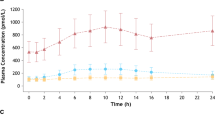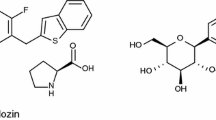Summary
The hypothesis that basic drugs can compete for active tubular secretion by the kidney was tested in six healthy volunteers by comparing the single dose pharmacokinetics of oral procainamide before and during a daily dose of cimetidine. The area under the procainamide plasma concentration-time curve was increased by cimetidine by an average of 35% from 27.0±0.3 µg/ml·h to 36.5±3.4 µg/ml·h. The elimination half-life increased from an harmonic mean of 2.92 to 3.68 h. The renal clearance of procainamide was reduced by cimetidine from 347±46 ml/min to 196±11 ml/min. All these results were statistically significant (p<0.016). The area under the plasma concentration-time curve for n-acetylprocainamide was increased by a mean of 25% by cimetidine due to a significant (p<0.016) reduction in renal clearance from 258±60 ml/min to 197±59 ml/min. The data suggests that cimetidine inhibits the tubular secretion of both procainamide and n-acetylprocainamide, and, if so, represents the first documented evidence for this type of drug interaction in man. The clinical implications from this study necessitate dosage adjustments of procainamide in patients being concomitantly treated with cimetidine. The interaction is pertinent not only for basic drugs that are cleared by the kidney, but also for metabolites of basic drugs and endogenous substances which require active transport into the lumen of the proximal tubule of the kidney for their elimination.
Similar content being viewed by others
References
Bekersky I, Colburn WA (1980) Acetylation of sulfisoxazole by isolated perfused rat kidney. J Pharm Sci 69: 1359
Brown JE, Shand DG (1982) Therapeutic drug monitoring of antiarrhythmic agents. Clin Pharmacokinet 7: 125–148
Burgess E, Blair A, Krichman K, Cutler RE (1982) Inhibition of renal creatinine secretion by cimetidine in humans. Renal Physiol 5: 27–30
Connolly SJ, Kates RE (1982) Clinical pharmacokinetics of N-acetylprocainamide. Clin Pharmacokinet 7: 206–220
Daniel WW (1978) Applied nonparametric statistics. Houghton Mifflin, Boston, pp 135–139
Drayer DE, Romankiewicz J, Lorenzo B, Reidenberg MM (1982) Age and renal clearance of cimetidine. Clin Pharmacol Ther 31: 45–50
Dubb JW, Stote RM, Familiar RG, Lee K, Alexander F (1978) Effect of cimetidine on renal function in normal man. Clin Pharmacol Ther 24: 76–83
Dutcher JS, Strong JM, Lucas SV, Lee W-K, Atkinson AJ (1977) Procainamide and N-acetylprocainamide kinetics investigated simultaneously with stable isotope methodology. Clin Pharmacol Ther 22: 447–457
Dutt MK, Moody P, Northfield TC (1981) Effect of cimetidine on renal function in man. Br J Clin Pharmacol 12: 47–50
Elson J, Strong JM, Lee W-K, Atkinson AJ (1975) Antiarrhythmic potency of N-acetylprocainamide. Clin Pharmacol Ther 17: 134–140
Feely J, Wilkinson GR, Wood AJJ (1981) Reduction of liver blood flow and propranolol metabolism by cimetidine. N Engl J Med 304: 692–695
Feely J, Wilkinson GR, McAllister CB, Wood AJJ (1982) Increased toxicity and reduced clearance of lidocaine by cimetidine. Ann Intern Med 96: 592–594
Galeazzi RL, Sheiner LB, Lockwood T, Benet LZ (1976) The renal elimination of procainamide. Clin Pharmacol Ther 19: 55–62
Gibson TP, Atkinson AJ, Matusik E, Nelson LD, Briggs WA (1977) Kinetics of procainamide and N-acetylprocainamide in renal failure. Kidney Int 12: 422–429
Hearse DJ, Weber WW (1973) Multiple N-acetyltransferases and drug metabolism: Tissue distribution, characterization and significance of mammalian N-acetyltransferase. Biochem J 132: 519–526
Jacobson HR (1981) Functional segmentation of the mammalian nephron. Am J Physiol 241: F203-F218
Koch-Weser J (1977) Serum procainamide levels as therapeutic guides. Clin Pharmacokinet 2: 389–402
Koch-Weser J, Klein SW (1971) Procainamide dosage schedules, plasma concentrations, and clinical effects. J Am Med Assoc 215: 1454–1460
Lai C-M, Kamath BL, Look ZM, Yacobi A (1980) Determination of procainamide and N-acetylprocainamide in biological fluids by high-pressure liquid chromatography. J Pharm Sci 69: 982–984
Manion CV, Lalka D, Baer DT, Meyer MB (1977) Absorption kinetics of procainamide in humans. J Pharm Sci 66: 981–984
McKinney TD, Speeg KV (1981) Heterogeneity for organic base transport in rabbit proximal tubules. Clin Res 29: 850A
McKinney TD, Speeg KV (1982) Cimetidine and procainamide secretion by proximal tubules in vitro. Am J Physiol 242: F672-F680
Olsen H, Mørland J (1982) Ethanol-induced increase in procainamide acetylation in man. Br J Clin Pharmacol 13: 203–208
Peters L (1960) Renal tubular excretion of organic bases. Annu Rev Pharmacol Toxicol 12: 1–35
Reidenberg MM, Camacho M, Kluger J, Drayer DE (1980) Aging and renal clearance of procainamide and acetylprocainamide. Clin Pharmacol Ther 28: 732–735
Rennick BR (1972) Renal excretion of drugs: Tubular transport and metabolism. Ann Rev Pharmacol Toxicol 12: 141–156
Rennick BR (1981) Renal tubule transport of organic cations. Am J Physiol 240: F83-F89
Roden DM, Reele SB, Higgins SB, Wilkinson GR, Smith RF, Oates JA, Woosley RL (1980) Antiarrhythmic efficacy, pharmacokinetics and safety of N-acetylprocainamide in human subjects. Comparison with procainamide. Am J Cardiol 46: 463–468
Schentag JJ, Cerra FB, Calleri GM, Leising ME, French MA, Bernhard H (1981) Age, disease, and cimetidine disposition in healthy subjects and chronically ill patients. Clin Pharmacol Ther 29: 737–743
Somogyi A, Gugler R (1982) Drug interactions with cimetidine. Clin Pharmacokinet 7: 23–41
Somogyi A, Heinzow B (1982) Cimetidine reduces procainamide elimination. N Engl J Med 307: 1080
Somogyi A, Rohner H-G, Gugler R (1980) Pharmacokinetics and bioavailability of cimetidine in gastric and duodenal ulcer patients. Clin Pharmacokinet 5: 84–94
Strong JM, Dutcher JS, Lee W-K, Atkinson AJ (1975) Pharmacokinetics in man of the N-acetylated metabolite of procainamide. J Pharmacokinet Biopharm 3: 223–235
Author information
Authors and Affiliations
Rights and permissions
About this article
Cite this article
Somogyi, A., McLean, A. & Heinzow, B. Cimetidine-procainamide pharmacokinetic interaction in man: Evidence of competition for tubular secretion of basic drugs. Eur J Clin Pharmacol 25, 339–345 (1983). https://doi.org/10.1007/BF01037945
Received:
Accepted:
Issue Date:
DOI: https://doi.org/10.1007/BF01037945




